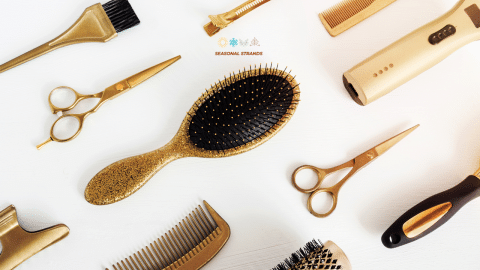As the frost of winter melts away, and the buzz of spring begins to echo in our surroundings, it’s not just the weather and wardrobes that merit an overhaul; our personal grooming routines do too—starting with our hair. Embarking on a mindful spring reset for your hair can seem daunting, yet when approached with the guidance of well-researched and industry-backed insights, it becomes an empowering journey toward greater hair health. Welcome to your definitive guide on revolutionizing your seasonal hair care rhythm while ensuring that every strand is as vibrant and thriving as the season itself.
—
Why Spring is the Perfect Time for a Hair Reset
Seasonal changes exert profound effects not just on the environment but also on our bodies. Our hair, exposed as it is to these shifting conditions, undergoes its own cycle of response and adaptation. Winter threatens your locks with cold, dry air, resulting in brittleness and unwelcome breakage. With the onset of spring comes a natural rejuvenation process, making it an ideal time for adjusting your hair care routine. 💆♀️
**Research Insight:** A study published in the *International Journal of Trichology* noted that hair density and growth rates often see improvement in spring due to increased daylight and generally better nutrition, making it an opportune time for growth-oriented hair routines.
The Importance of a Seasonal Hair Care Rhythm
A seasonal hair care rhythm honors and responds to the climate’s natural cadence. By adapting your practices to environmental changes, you support your hair’s inherent capacity to recover and thrive. Think of it as aiding your scalp and hair through seasonal transitions or what industry experts often call the “transition wellness period.” Enhancing this relationship not only mitigates damage but promotes overall hair resilience. 🌿
—
Understanding the Nature of Spring Hair Needs
Before establishing a hair care routine adjustment for this new season, it helps to understand the primary challenges spring introduces. These include:
Humidity Changes
With increasing humidity levels, your scalp’s oil production might increase, leading to greasy hair. But before damping spirits, consider using:

- Clarifying Shampoos: Designed specifically to lift oils and residues that accumulate over time due to humid conditions.
Increased Sun Exposure
Spring’s pleasant warmth can become deceptive, resulting in sun-induced damage. Consider:
- UV Protection Products: Effective in shielding hair from potentially harmful UV rays. According to industry data, 62% of hair damage can be linked to consistent UV exposure over time.
Allergy-Related Issues
Pollens and allergens peak in spring, which can cause itchy scalps. This is counteracted by:
- Calming Scalp Treatments: Anti-inflammatory ingredients like tea tree oil and aloe vera can significantly assist in alleviating these symptoms.
—
Creating Your Spring-Specific Hair Care Routine
Step 1: Nutrient-Rich Diet
Your hair’s vitality is mirrored in your diet. Integrate antioxidants and proteins to nourish your hair from within:
- Omega-3 Fatty Acids: Found in fatty fish and flaxseeds; essential to keep your scalp hydrated and free from dryness.
- Biotin & Vitamin E: Essential in combating hair thinning. Anecdotal evidence supports biotin-rich interventions leading to increasing hair fullness in as little as 8 weeks.
Step 2: Adopt a Gentler Shampoo Strategy
Consider alternating between a mild, sulfate-free shampoo and a more robust cleansing agent:
- Product Tip: Brands focusing on botanical extracts (like chamomile) offer deep cleansing power without stripping natural oils essential for hair health.
Step 3: Integrate Hair Masks and Serums

Adopt a core ritual of nourishment each week through masks and serums with intensive ingredients like keratin and silk proteins:
- Protein Enrichment Sessions: Scientific studies from The Journal of Cosmetic Dermatology found that keratin-infused treatments boost hair elasticity by 35%.
Step 4: Trim and Protect Ends
Regular trimming mitigates breakage exacerbated by weather transition:
- Experts recommend a 6- to 8-week trim cycle to prevent split ends, ensuring healthy growth and optimal style results during the growing season.
- Heat Protectants: Assure supplemental support during styling to prevent structural weakening of hair proteins due to thermal exposure.
—
Debunking Hair Care Myths
In pursuit of the ideal hair care regimen, it’s easy to fall prey to common misconceptions. Let’s examine and debunk these misunderstandings with research-concrete clarity:
**Myth 1: Frequent Washing is Necessary in Spring**
While oil production tends to increase, frequent washing may strip essential oils and irritate the scalp. Invest in dry shampoo as a refreshing agent without interference with natural oils.
**Myth 2: Hair Doesn’t Grow Faster in Warmer Months**
While individual results vary, scientific backing recognizes seasonal hair growth acceleration. Thus, prioritizing care routines during these months reaps more substantial benefits.
**Myth 3: All Hair Care Products Are Season-Proof**
Believe in the funnel of tailored routines. Spring demands moisture and protection-focused products, while drier winter months likely necessitate deeper hydration for damage repair.

—
Case Studies in Spring Hair Revival
Consider these real-life scenarios that pivotally explored seasonal hair care rhythm alterations resulting in tangible success:
Case Study 1: Revitalizing Crista’s Curly Locks
Crista, a software engineer, formulated her spring regimen focusing on moisture-locking conditioners and weekly heat protégées. The transformation?
- Result: Defined curl patterns and a decrease in frizz over an 8-week transition marked by softer, healthier cuticles.
Case Study 2: From Aberrant to Achievable—Mark’s Straight Appeal
Marketing executive Mark switched to UV-protectant products post styling his layered straight hair, effectively protecting against flatness and dryness.
- Result: Fullness and visible shine observed pre-summer, bolstered confidence with hairstyle longevity enhanced by twice-monthly trims.
—
The Final Spring Takeaway 🌸
Every mindful decision in your seasonal hair care routine shares the promise of amplified resilience and rejuvenation. Greater consciousness of your hair’s condition and environmental influences allows not only for actionable insights but exemplary adaptability from within.
By listening to your hair and tailoring your regimen accordingly, you embrace the beauty of even the most subtle seasonal transitions. In the symphonic occurrence of growth and nourishment, find peace in the balance of both nature and the essence of hair itself.
For readers venturing into their season of hair renewal, remember: Each strand has a story, and through meticulous care, you’re leading each one toward its fullest potential. Happy Spring Reset!
—
This guide empowers you to confidently navigate your spring transition—make each day a celebration of wellness, health, and harmonious balance between nature’s vibrancy and your hair’s innate glory. 🌱💁♂️
Frequently Asked Questions
What are the benefits of using a hair mask in my hair care routine?
Using a hair mask can provide several benefits, including hydration, smoothing, strengthening, curl definition, heat protection, and damage repair. Hair masks infuse the hair with moisture, help coat the hair shaft to seal split ends, reduce breakage, and protect the hair from heat styling and environmental damage[1][4].
What ingredients should I look for in a hair mask?
Effective hair masks often include ingredients such as coconut oil, argan oil, shea butter, honey, avocado oil, green tea, and coconut water. These ingredients provide nourishment, moisturize, and protect the hair, offering benefits like softening, moisturizing, and protecting against damage[2][5].
How often should I use a hair mask in my routine?
You should use a hair mask whenever your hair feels dry, unmanageable, or in need of intense hydration. This can vary depending on your hair type and needs, but generally, using a hair mask once or twice a week can help maintain healthy and moisturized hair[1][4].
How do I apply a hair mask for the best results?
To apply a hair mask effectively, shampoo your hair first, then apply the mask, focusing especially on the ends where hair tends to be the most damaged. Leave the mask on for anywhere from 10 minutes to overnight, depending on the type of mask and your hair’s needs[1][4].
References










